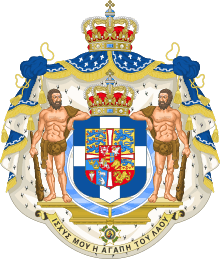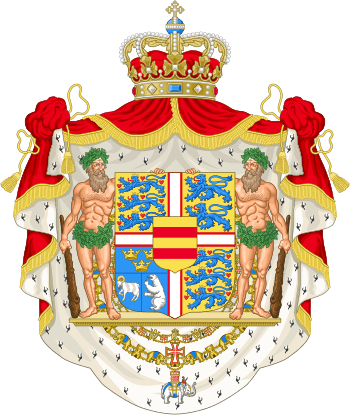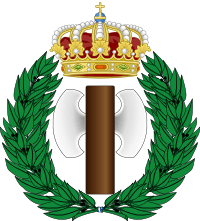George II of Greece
George II (Greek: Γεώργιος Βʹ, Geórgios II; 19 July [O.S. 7 July] 1890 – 1 April 1947) reigned as King of Greece from 1922 to 1924 and from 1935 to 1947. He was a paternal first cousin of Prince Philip, Duke of Edinburgh, and a maternal nephew of Wilhelm II, the last German Emperor.
| George II | |
|---|---|
.jpg) Photograph, c. 1942 | |
| King of the Hellenes | |
| First reign | 27 September 1922[1] – 25 March 1924 |
| Predecessor | Constantine I |
| Successor | Republic proclaimed |
| Prime Ministers | |
| Second reign | 25 November 1935 – 1 April 1947 |
| Predecessor | Republic abolished |
| Successor | Paul |
| Prime Ministers | |
| Born | 19 July 1890 (NS) Tatoi Palace, Greece |
| Died | 1 April 1947 (aged 56) Athens, Greece |
| Burial | 6 April 1947 Royal Cemetery, Tatoi Palace, Greece |
| Spouse | |
| House | Glücksburg |
| Father | Constantine I of Greece |
| Mother | Sophia of Prussia |
| Religion | Greek Orthodox |
| Signature | |
Early life, first period of kingship and exile

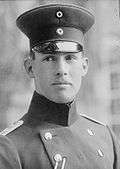
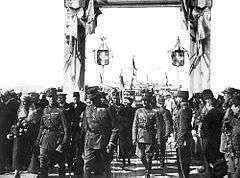
George was born at the royal villa at Tatoi, near Athens, the eldest son of Crown Prince Constantine of Greece and his wife, Princess Sophia of Prussia. George pursued a military career, training with the Prussian Guard at the age of 18, then serving in the Balkan Wars as a member of the 1st Greek Infantry. When his grandfather was assassinated in 1913, his father became King Constantine I and George became the crown prince.
After a coup deposed King Constantine during the First World War, Crown Prince George, by then a major, followed his father into exile in 1917 (see National Schism). George's younger brother, Alexander, was installed as king by prime minister Eleftherios Venizelos, an avowed Republican.
When Alexander I died following an infection from a monkey bite in 1920, Venizelos was voted out of office, and a plebiscite restored Constantine to the throne. Crown Prince George served as a colonel, and later a major general in the war against Turkey. During this time he married his second cousin, on 27 February 1921 in Bucharest, Princess Elisabeth of Romania, daughter of King Ferdinand and Queen Marie of Romania. When the Turks defeated Greece at the Battle of Dumlupınar, the military forced the abdication of Constantine, and George succeeded to the Greek throne on 27 September 1922.[2]
Following a failed royalist coup in October 1923, the Revolutionary Committee asked him to leave Greece while the National Assembly considered the question of the future form of government. He complied and, although he refused to abdicate, he departed on 19 December 1923 for exile in his wife's home nation of Romania. When a republic was proclaimed on 25 March 1924, he was officially deposed and stripped of his Greek nationality, and his property was confiscated.[3] A cold, aloof man, George rarely inspired love or affection from those knew him, and certainly not from the vast majority of his subjects.[4] Many commented that his moody, sullen personality seemed more appropriate for his ancestral homeland of Denmark than Greece.[4] Furthermore, George's long years spent living abroad had led him to a mentality that was essentially Western European in outlook.[4] He had come to see Greece very much as Western Europeans did at the time, namely as a primitive, backward Balkan state inhabited by people who were romantic, but savage.
During his exile, George's wife stayed in Bucharest whilst he spent more and more time abroad visiting Britain, and his mother in Florence. In 1932 he left Romania permanently and moved to Britain.[5] He and Elisabeth had no children, and were divorced on 6 July 1935.[6] George's principal love was his English mistress, Joyce Brittain-Jones, whom he called J.[4]
Restoration of monarchy and the Metaxas regime
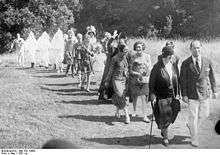
In Greece between 1924 and 1935 there were 23 changes of government, a dictatorship, and 13 coups. General Georgios Kondylis, a former Venizelist who had suddenly decided to throw in his lot with the monarchist forces, overthrew the government in October 1935 and appointed himself prime minister. He then arranged a plebiscite both to approve his government and to bring an end to the republic. On 3 November 1935, almost 98% of the reported votes supported restoration of the monarchy.[7] The balloting was not secret, and participation was compulsory. As Time described it at the time, "As a voter one could drop into the ballot box a blue vote for George II and please General George Kondylis, or one could cast a red ballot for the Republic and get roughed up."[8]
George, who had been living at Brown's Hotel in London, returned to Greek soil on 25 November. Almost immediately he and Kondylis disagreed over the terms of a general amnesty the King wanted to declare, and George appointed an interim prime minister, Konstantinos Demertzis. New elections were held in January, which resulted in a hung parliament with the Communists (who were naturally anti-monarchist) holding the balance of power. A series of unexpected deaths amongst the better-known politicians (including Kondylis and Demertzis), as well as the uncertain political situation, led to the rise to power of veteran army officer Ioannis Metaxas. On 4 August 1936, George endorsed Metaxas's establishment of dictatorship – the "4th of August Regime",[9] signing decrees that dissolved the parliament, banned political parties, abolished the constitution, and purported to create a "Third Hellenic Civilization".[10] The king, ruling with Prime Minister Metaxas, oversaw a right-wing regime in which political opponents were arrested and strict censorship was imposed. An Index of banned books during that period included the works of Plato, Thucydides and Xenophon.[10] George disliked dealing with both Greek politicians and ordinary Greeks, and preferred to let Metaxas undertake tours of the provinces.[11] His support for the 4th of August Regime ended the limited popularity that he enjoyed in Greece.[12]
World War II
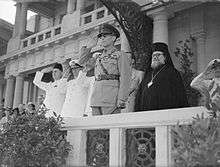
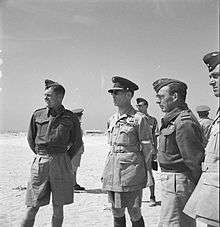
Italian and German invasions
Despite the nationalist government's strong economic and military ties to Germany, a connection which continued with Nazi Germany, King George was known to have pro-British feelings at the start of World War II. On 28 October 1940, Metaxas rejected an Italian ultimatum demanding the stationing of Italian troops in Greece, and Italy invaded, starting the Greco-Italian War. The Greeks mounted a successful defense and eventually occupied the southern half of Albania (then an Italian protectorate), but when the Germans invaded from Bulgaria on 6 April 1941, the Greeks and the British Expeditionary Force were overrun, and mainland Greece was occupied.[13]
Crisis of April 1941 and evacuation to Crete
Following the suicide of Prime Minister Alexandros Koryzis on 18 April 1941 in the face of the rapid German advance, George found himself as the de facto head of government (as well as head of the three armed services ministries) for a few days, as he cast around for a potential successor.[14] The King had thus a unique opportunity to form a broader government of national consensus, and abolish the hated dictatorial regime—whose sole bastion of support he now was. Although he was urged to this step by the influential British ambassador, Michael Palairet, George refused.[14]
Instead, several names were put forward to head a government. George initially proposed Konstantinos Kotzias, one of Metaxas' ministers, but his ties to the regime made him an unfeasible choice; veteran Venizelist general Alexandros Mazarakis-Ainian was given the mandate to form a government, but returned it on 20 April, partly due to his refusal to collaborated with Metaxas' hated security minister Konstantinos Maniadakis; other figures, such as the former dictator Theodoros Pangalos, were rejected.[15] Finally, the next day, Emmanouil Tsouderos, former governor of the Bank of Greece, was sworn in, chiefly on account of his known Anglophile sentiments, Venizelist past, and Cretan origin; the government was preparing to evacuate to Crete, which cherished the memory of Venizelos and was largely anti-monarchical, and this appointment was seen as a sop to local sentiment.[16]
On 23 April the King and the government left the Greek mainland for Crete,[17] but after the German airborne attack on the island, George was evacuated to Egypt. Once again he went into exile to Great Britain, seemingly at the behest of King Farouk of Egypt and Farouk's pro-Italian ministers.[18]
In exile
During the war he remained the internationally recognized head of state, backed by the exiled government and Greek forces serving in the Middle East. The British Foreign Office found the king an exceedingly difficult man to deal with, as the king was deeply obstinate about upholding what he regarded as his royal prerogatives, and proved notably unwilling to compromise with those who wanted a clear break with the 4th of August Regime.[4] George long resisted British pressure to promise to restore the constitution of 1911, under the grounds to do so would be to admit that he acted illegally in suspending the constitution on 4 August 1936.[19] Likewise, George kept on until 1942 cabinet ministers from the Metaxas regime, most notably Maniadakis.[20] Under heavy British pressure, George in a radio broadcast on 28 October 1941 reluctantly proclaimed the end of the 4th of August Regime, and only in February 1942 did he promise to restore articles 5, 6, 10, 12, 14, 20 and 95 of the 1911 constitution.[21]
A deeply paranoid and insecure man, George believed that the British government was plotting to prevent his return to Greece, despite all of the evidence to the contrary.[4] Edward Warner of the Southern Department of the Foreign Office wrote in March 1942 that the king was "under the extraordinary impression that the Foreign Office was 'pro-Republican and anti-himself'".[22] The British ambassador to the government-in-exile, Sir Reginald Leeper, noted that the king's coldness did not win him many friends, writing: "Amongst these vivacious, talkative and intensely political southerners he is very much the reserved northerner who damps the ardour of those who might otherwise acclaim him".[4] Leeper noted that almost every meeting he had with the king, he had to listen to a lengthy litany of complaints.[19] In particular, the king objected to BBC's Greek language service, where the main radio announcer, G.N. Soteriadis, was a Venizelist.[23] George repeatedly asked that Soteriadis be fired and replaced with a monarchist.[24] One of George's few friends was the British Prime Minister Winston Churchill, who was determined to see him restored and tended to back the king's complaints against his own officials.[25]
In occupied Greece, however, the leftist partisans of the National Liberation Front (EAM) and National Popular Liberation Army (ELAS), now unfettered by Metaxas' oppression, had become the largest Greek Resistance movement, enjoying considerable popular support. As liberation drew nearer, however, the prospect of the King's return caused dissensions both inside Greece and among the Greeks abroad. Although the King effectively renounced the Metaxas regime in a radio broadcast, a large section of the people and many politicians rejected his return on account of his support of the dictatorship. In November 1943 George wrote to the Prime Minister-in-exile Emmanouil Tsouderos, "I shall examine anew the question of the date of my return to Greece in agreement with the Government". Either deliberately or accidentally, the version released for publication omitted the words "of the date", creating the impression that George had agreed to a further plebiscite on the monarchy, even though a retraction was issued.[26]
After two changes of Prime Minister, the establishment of a rival Communist-led government in occupied Greece and a pro-EAM mutiny among the armed forces in the Middle East, it was agreed in the May 1944 Lebanon conference that the fate of the monarchy would be decided in a national referendum. George was very much opposed to a regency, and tried his best to turn his friend Winston Churchill against Archbishop Damaskinos of Athens, accusing him of being a Communist and a Nazi collaborator.[27] As late as Christmas Eve 1944, during the height of the Dekemvriana, George had rejected the compromise solution of a regency, demanding that he return to Greece at once to reclaim his throne.[28] On 29 December 1944, at a meeting at 10 Downing Street Churchill told the king "...that if he did not agree to the matter would be settled without him, and that we should recognise the new Government instead of him"..[29] The king's private secretary recalled: "I could hear through the door the voices of Churchill and Eden, particularly the latter, raised in anger at the King. In this heated argument the door was flung open and the King stormed out, his face white and taut...In the car as we drove back to the hotel the King would not trust himself to speak; after recovering his composure he went back to Downing Street and informed Churchill and Eden that had no choice but to acquiesce to their demands".[30]
Bowing to Allied pressure, George was forced to appoint Archbishop Damaskinos of Athens as Regent in January 1945. Damaskinos immediately appointed a republican-dominated government. Ill, exhausted and powerless, George bought a lease on a house in Chester Square, Belgravia, and made a home there with his long-time mistress.[31]
Return to Greece and death


In elections held on 31 March 1946 the monarchist parties won a clear majority of the parliamentary seats, aided by the abstention of the Communists, and the referendum on the monarchy was set for 1 September. Between then and the plebiscite, the electoral registers were revised under Allied supervision. The announced results claimed 68.4% in favour of the King's return on an 86.6% turnout.[32] However, even Allied observers acknowledged that the official results were marked by significant fraud by monarchist supporters. In the words of the official Allied observation report, "There is no doubt in our minds that the party representing the government view exercised undue influence in securing votes in support of the return of the King."[33]
On 26 September George returned to Greece to find the Royal Palace looted, the woods at Tatoi chopped down for fuel and corpses buried in shallow graves outside.[34] His country faced economic collapse and political instability.
He died of arteriosclerosis on 1 April 1947, after he was discovered unconscious in his room at the Royal Palace in Athens. When the news was announced some thought it to be an April Fool's Day joke.[35]
His funeral was held on 6 April at the Orthodox Metropolitan Cathedral of Athens.
He was succeeded by his younger brother, Paul. On account of his many exiles, he is said to have remarked that "the most important tool for a King of Greece is a suitcase."[36]
| Styles of King George II of the Hellenes | |
|---|---|
| Reference style | His Majesty |
| Spoken style | Your Majesty |
Honours
.svg.png)
- Order of St. George and St. Constantine, Founder, January 1936
- Order of Saints Olga and Sophia, Founder, January 1936

- Knight with Collar of the Elephant, 15 August 1909[39]
- Cross of Honour of the Order of the Dannebrog, 15 August 1909
.svg.png)
_crowned.svg.png)





- Knight of the Garter, 7 November 1938[45]
- Bailiff Grand Cross, Venerable Order of St John[46]
- Companion of the Distinguished Service Order[47]
Ancestry
References
| Wikimedia Commons has media related to George II of Greece. |
- Note: Greece officially adopted the Gregorian calendar on 16 February 1923 (which became 1 March). All dates prior to that, unless specifically denoted, are Old Style.
- John Van der Kiste (1994). Kings of the Hellenes. Stroud, Gloucestershire: Alan Sutton Publishing. pp. 136–137. ISBN 0-7509-0525-5.
- Van der Kiste, p. 144.
- Brewer 2016, p. 118.
- Van der Kiste, pp. 145–146
- Van der Kiste, p. 151.
- Van der Kiste, p. 153.
- By the Grace of God, Time Magazine, 18 November 1935.
- Van der Kiste, pp. 154–156.
- Current Biography 1943, pp. 225–229.
- Close p.42
- Close p.42
- Van der Kiste, pp. 161–162.
- Koliopoulos 1976–1977, pp. 68–69.
- Koliopoulos 1976–1977, pp. 68–71.
- Koliopoulos 1976–1977, pp. 71–72.
- Koliopoulos 1976–1977, p. 74.
- Van der Kiste, p. 164.
- Brewer 2016, p. 119.
- Brewer, p.119-120
- Clogg, p. 384-385
- Clogg, p. 392
- Clogg, p. 392
- Clogg, p. 392
- Clogg, p. 392
- Van der Kiste, pp. 165–167.
- Brewer 2016, p. 198.
- Brewer 2016, p. 199.
- Brewer 2016, p. 200.
- Brewer 2016, pp. 200-201.
- Van der Kiste, p. 171.
- Van der Kiste, p. 172.
- Report by Messrs. Richard T. Windle and Leland Morris, Chiefs of the Allied Mission To Observe the Greek Elections, 7 September 1946.
- Van der Kiste, p. 173.
- Van der Kiste, p. 175.
- Antony Beevor (2004). Crete: The Battle and the Resistance. Athens: Govostis Pub. p. 104. ISBN 960-270-927-8.
- "Greek Royal Orders" (PDF). Official website of the Greek royal family. Retrieved 7 October 2012.
- Kongelig Dansk Hof-og Statskalendar (1943) (in Danish), "De Kongelig Danske Ridderordener", p. 82.
- "Image: 6690606681_8e10e2859f.jpg, (320 × 500 px)". farm8.static.flickr.com. Retrieved 15 September 2015.
- M. & B. Wattel (2009). Les Grand'Croix de la Légion d'honneur de 1805 à nos jours. Titulaires français et étrangers. Paris: Archives & Culture. p. 467. ISBN 978-2-35077-135-9.
- "Recipients of the Order of the Most Holy Annunciation". web.archive.org. Archived from the original on 2 April 2015. Retrieved 15 September 2015.
- "9781233121632: Recipients of the Norwegian War Cross with Sword: Olav V of Norway, Haakon VII of Norway, George II of Greece, Leif Tronstad - AbeBooks: 1233121634". abebooks.com. Retrieved 15 September 2015.
- "Flickr - Photo Sharing!". flickr.com. Retrieved 15 September 2015.
- Sveriges statskalender (in Swedish). 1925. p. 807. Retrieved 6 January 2018 – via runeberg.org.
- List of Knights of the Garter - 1348 to present – via heraldica.org.
- "Image: gre_georgeII.jpg, (394 × 401 px)". oocities.org. Retrieved 15 September 2015.
- "King George II - Royal Greek Family". greekroyalfamily.gr. Retrieved 15 September 2015.
- Bricka, Carl Frederik (ed.). "Christian IX". Dansk Biografisk Leksikon. 3. p. 523.
- Bricka, Carl Frederik (ed.). "Louise". Dansk Biografisk Leksikon. 5. p. 593.
- Chisholm, Hugh, ed. (1911). . Encyclopædia Britannica. 11 (11th ed.). Cambridge University Press.
- Bricka, Carl Frederik (ed.). "Louise". Dansk Biografisk Leksikon. 10. p. 401.
- Nicholas I at the Encyclopædia Britannica
- "Olga Constantinovna (1851–1926)". Women in World History: A Biographical Encyclopedia. Gale Research. 2002.
- "Alexandra of Saxe-Altenburg (1830–1911)". Women in World History: A Biographical Encyclopedia. Gale Research. 2002.
- "Biografie Wilhelm I" (in German). Deutsches Historisches Museum. Retrieved 12 June 2013.
- Meisner, Heinrich Otto (1961), "Friedrich III", Neue Deutsche Biographie (NDB) (in German), 5, Berlin: Duncker & Humblot, pp. 487–489; (full text online)
- Goetz, Walter (1953), "Augusta", Neue Deutsche Biographie (NDB) (in German), 1, Berlin: Duncker & Humblot, pp. 451–452; (full text online)
- Montgomery-Massingberd, Hugh (ed.) (1977). Burke's Royal Families of the World, 1st edition. London: Burke's Peerage
- Louda, Jiří; Maclagan, Michael (1999), Lines of Succession: Heraldry of the Royal Families of Europe, London: Little, Brown, p. 34, ISBN 978-1-85605-469-0
Sources
- Brewer, David (2016). Greece, The Decade of War: Occupation, Resistance, and Civil War. I.B. Tauris. ISBN 1780768540.CS1 maint: ref=harv (link)
- Clogg, Richard (July 1979). "The Greek Government-in-Exile 1941-4". The International History Review. 1 (3). Cambridge University Press.
- Koliopoulos, Ioannis S. (1976–1977). "Η στρατιωτική και πολιτική κρίση στην Ελλάδα τον Απρίλιο του 1941" [The Military and Political Crisis in Greece in April 1941] (PDF). Μνήμων (in Greek). 6: 53–74.CS1 maint: ref=harv (link)
External links
George II of Greece House of Schleswig-Holstein-Sonderburg-Glücksburg Cadet branch of the House of Oldenburg Born: 19 July 1890 Died: 1 April 1947 | ||
| Regnal titles | ||
|---|---|---|
| Preceded by Constantine I |
King of the Hellenes 27 September 1922 – 25 March 1924 |
Vacant |
| Vacant | and 3 November 1935 – 1 April 1947 |
Succeeded by Paul |
